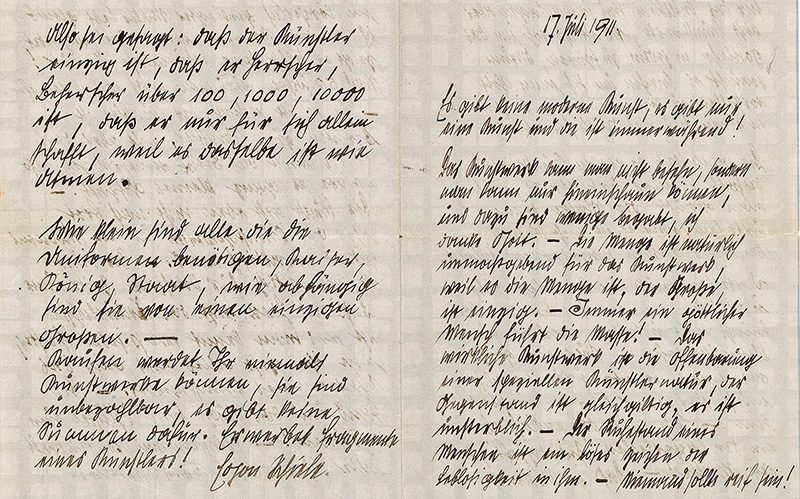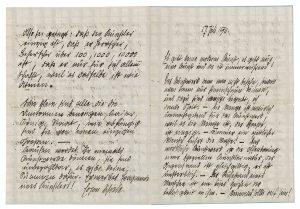
“ART IS PERPETUAL!”
Egon Schiele was one of the foremost painters of the Modernist movement and the discovery of his previously unknown artistic manifesto, which he wrote at just 21 years of age, is nothing short of a sensation. The manifesto is for sale at the auction on the 26 November 2019. It is the most complex illustration to date of the artistic self-image of Schiele as an emerging and exceptional talent.
by TOBIAS G. NATTER
Egon Schiele, one of the most important artists in international Modernism, was proud of his talent for both painting and language. The latter is expressed in numerous texts. These texts have long provided the basis for an aspect that has become essential in the study of Schiele, as Ursula Storch explains in her article about text and language in Egon Schiele’s work. It is rare however for a Schiele document, as yet unknown to scholars, to emerge these days. This makes this new discovery all the more exciting, with the content and thrust of the text giving it the character of a manifesto.
“Art is perpetual.” Schiele launches the first sentence of his exposition with a bang. Surprisingly, this revolutionary artist was not emphasising a break with convention, but was drawing attention to the continuous, never-ending, perpetual character of great art as something immortal and eternal. This avowal from the pen of the young artist, co-founder of early Austrian Expressionism and much-berated breaker of taboos, should in no way be taken for granted. Schiele believed that timelessness was essential, and that viewing art was not just about seeing it, but about looking into its very essence. He believed an artwork to be a revelation arising from necessity, and that more than just a minor contribution should be demanded from the audience. Schiele gave us a deep insight into his own perception of art. Even when an artwork is bought and sold, it remains, by its very nature, priceless.
Schiele was 21 years old when he wrote the text dated “17 July 1911”. His remarks cover all four pages of small-sized writing paper in closely written lines. There are no corrections or deletions to interrupt the flow of thought. The text feels seamless, has almost no grammatical errors, and looks like a clean copy. It is written on writing paper that has been folded once; the paper is remarkable for its blue edging and its blue-grey squaring. Schiele rarely used this unusual writing paper. Among all the handwritten documents that were proveably penned by him, the first to be written on this paper is a letter from the artist, dated 28 June 1911. Interestingly, he used it many times after that, but only during a short period of three months, between June and August 1911. So this newly discovered text, dated 17 July 1911, matches the known existing documents perfectly in terms of timing.
It is interesting to compare the contents of this message to other statements by Schiele. In the process, it becomes clear how important the key thoughts set down here were to him. Previously, Schiele’s commitment to “perpetual art” was mainly known from a text that was first published in March 1911 under the title “Draft of a written self-portrait”. He wrote “I believe there is no ‘modern’ art; there is only one art, and that art is perpetual.”

Schiele included a similar announcement in a letter to his uncle Leopold Czihaczek, two months later “I know there is no modern art, there is only one art – and that art is perpetual.” This letter, full of aphorisms, also contains the following sentence “A work of art can be purchased, but it is priceless.”
All of these are fundamental thoughts of a young high-flyer. When he wrote the text, Schiele had just celebrated his 21st birthday. We tend these days to forget how many career stages the young painter had already completed by then. He had abandoned his studies at 19, presented his Vienna debut exhibition at the “International Art Show” in 1909, and was already able to rely on enthusiastic support from private buyers and major collectors such as the industrialist Carl Reininghaus. He also had Arthur Roessler on his side, an expert impresario and string-puller. When Schiele presented his first solo exhibition between April and May 1911, it was at a prime location: H. O. Miethke in Dorotheergasse, a gallery that had exclusive representation of no less a figure than Gustav Klimt, and where Monet, Manet and the other great French Modernists were exhibited. It is fair to say, therefore, that Schiele’s entry into the art world was something of a vertical take-off. In 1911 the first Schiele painting was purchased in Germany for a museum. It was not until the following year, 1912, that Schiele received a setback. The Neulengbach affair involved his sentencing and imprisonment and almost derailed him.
As for the document: some passages in the text remain ambiguous. It mentions a “physically stout man” in Mödling for example, but it is unclear who that man is. Obviously Schiele felt seriously attacked by him (“the very moment he begins to slander, he demonstrates his own wretchedness!”). At that time, and in 1911 in particular, Schiele was constantly being accused of being artistically dependent, first on Gustav Klimt, and then, in 1910/11, on Oskar Kokoschka. But as far as his Mödling adversary was concerned, Schiele was certain of one thing: “In 50 years nothing will be known about him.” He was to be proved right. These kinds of attacks probably led Schiele to his conviction that not everybody is able to understand art, but some have the gift. From Schiele’s perspective, the conflict was a clear contrast between the masses – “the crowd naturally is irrelevant for the artwork” – and the “divinity of great art”.
This matches Schiele’s derogatory remarks about people in uniform (“how small are all those people who need uniforms”). With his fundamentally individualistic attitude, Schiele disliked anything uniform. Other documents tell us that he was seriously worried in 1911 about being drafted into the military. But he escaped the uniform – for the time being. This changed at the start of the First World War, when he was conscripted for military service.
Unfortunately, it is unclear to whom this newly discovered letter was addressed; we have not been able, so far, to reveal the recipient from the letter’s provenance. In any case, it is much more likely that Schiele’s fundamental message was never addressed to a single person. He may have used writing paper, but there is no addressee. Instead, the text feels more like a public declaration. And that seems fitting. Schiele was certain of his fundamental sense of mission as an artist at all times, even while in prison in 1912.
This newly discovered message ends with the following words “You will never be able to buy works of art for they are priceless, money cannot buy them. Buy fragments of an artist! Egon Schiele” The artist and draughtsman Egon Schiele was aware of the problematic nature of practising art for a living. But he saw himself in a different position. We can buy fragments, but these fragments are not snippets of an incomplete work; they are leading metaphors of Modernism, parts of a greater whole.
Tobias G. Natter is an internationally renowned exhibition organiser, expert and evaluator in the field of Viennese art. He was chief curator at the Österreichische Galerie Belvedere for a long time and went on to become artistic director of the vorarlberg museum, and later of the Leopold Museum. Most recently he curated the acclaimed exhibition “The Self-Portrait: From Schiele to Beckmann” at Neue Galerie New York (2019).
INFORMATION about the AUCTION
Auction date: Modern Art auction, 26th November 2019, 15 p.m.
Location: Palais Dorotheum, Dorotheergasse 17, 1010 Vienna
Exhibition: 16th November 2019 –26th November 2019
Information: Andreas Löbbecke, specialist for autographs at Dorotheum













